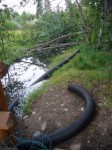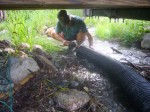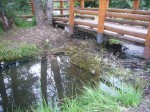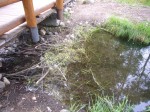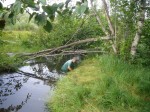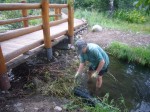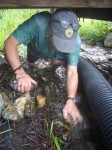Martinez is being deeply stupid at the moment. So we’re looking elsewhere for inspiration. Let’s start with Idaho and our old friend Mike Settell of the Watershed Guardians.
Groups help mitigate beaver dam problems
To help with the beaver dam’s problems, the Watershed Guardians installed a pond leveler in the same pond as the dam. The leveler helps maintain the pond’s water at a set level, regardless of the beavers’ actions.
“We set the level of the pond by adjusting where (the leveler) sets in the dam,” said Mike Settel, executive director of the Watershed Guardians. “We’re actually using the structure the beaver created to help keep the level where we want it to be.”
While the priority was to help with flooding, maintaining the pond’s level does more. By raising the water level it increases the amount of groundwater recharge, provides flows in-stream and helps with wildlife habitat. Particularly giving more water for fish.
Go Mike and the Watershed Guardians! I’ve been impressed with his beaver teaching since 2009 when he somehow got Pocatello Audubon to fund a beaver count! I pretty much talked him into interstate travel and his first beaver conference where Leonard Houston spontaneously gave him a venue to present. Then he met Mike Callahan, learned how to put in a flow device, and the rest (as they say) is history!
 And there’s more good news from our friends and the friends of beavers. This is from the Truckee River where Sherry and Ted Guzzi with the Sierra Wildlife Coalition have been making a world of difference.
And there’s more good news from our friends and the friends of beavers. This is from the Truckee River where Sherry and Ted Guzzi with the Sierra Wildlife Coalition have been making a world of difference.
Enjoying the beauty of beavers
 Sherry Guzzi from the Sierra Wildlife Coalition says that beaver dams “hold water on the land longer and allow it to recharge the water table, and help create habitat for fish and wildlife.” Researchers in Utah have found that beavers provide a direct positive impact to farmers and ranchers downstream by allowing the water to last later into the season.
Sherry Guzzi from the Sierra Wildlife Coalition says that beaver dams “hold water on the land longer and allow it to recharge the water table, and help create habitat for fish and wildlife.” Researchers in Utah have found that beavers provide a direct positive impact to farmers and ranchers downstream by allowing the water to last later into the season.
The dams also slow down and capture sediments on their way to Lake Tahoe and other bodies of water, acting as filtering or cleaning mechanisms. Research has found that the amount of phosphorus (which causes algae growth) entering Lake Tahoe took a spike upward when dams were removed from Taylor Creek to allow for the annual Kokanee salmon spawn in the fall.
Great work Sherry and Ted! You have single-handedly made Tahoe think twice about beavers. This is not an easy field to plow, since folks who invest money to move to nature generally don’t actually want messy nature to eat their petunias or dam their culverts. I couldn’t be more grateful for your hard work. And I absolutely LOVE your hat! 🙂
It made me think that we need a graphic like this. There are more photos lurking about from more beaver-saving gurus, but this will do for a start.













